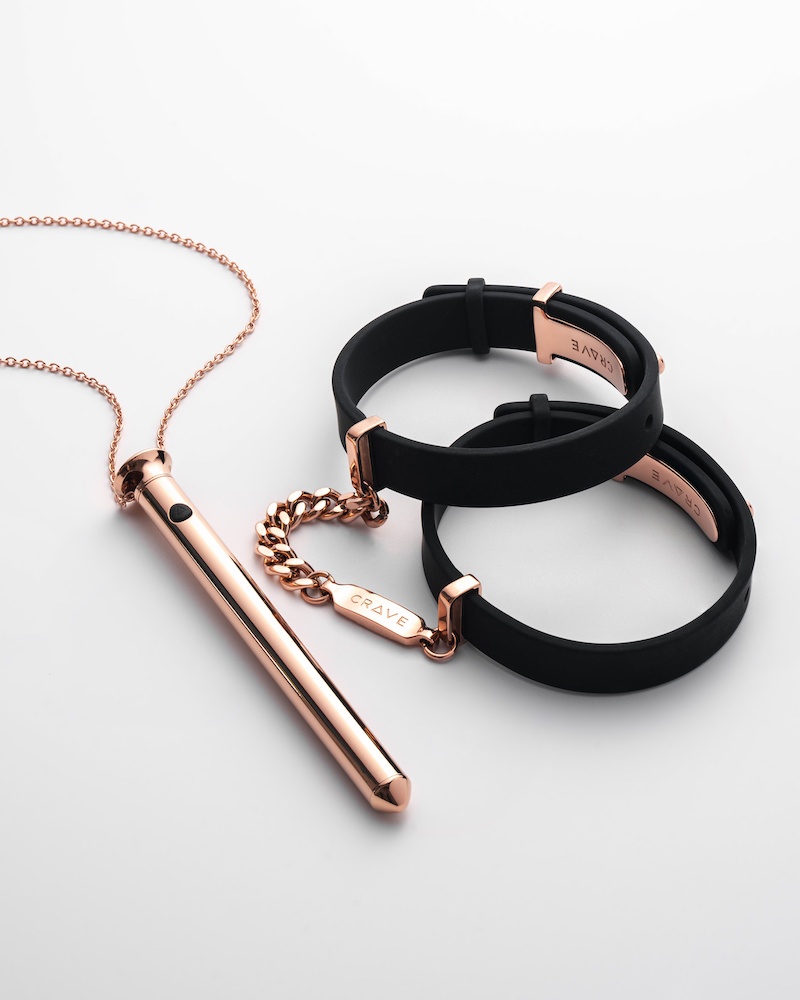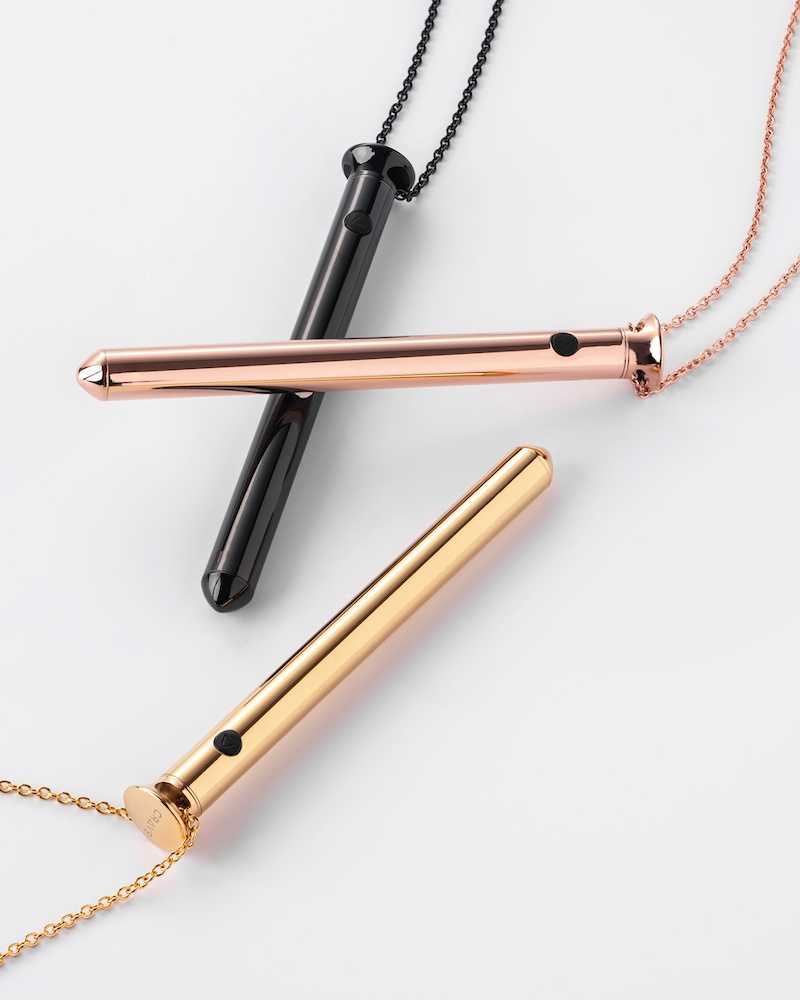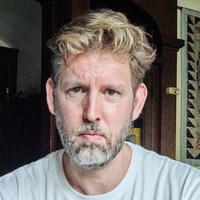On creating your own opportunities
Prelude
Ti Chang is the co-founder and Chief Design Officer of CRAVE, a luxury pleasure product company. Ti leads the design vision for the company’s full line of products which have won international design awards—including Red Dot, Good Design, Fast Company’s Innovation By Design—and were among the first pleasure products to be adopted by mainstream retailers such as Nordstrom and Goop, including a collaboration with Saint Laurent. She is best known for mainstreaming the category of pleasure jewelry with the introduction of the Vesper necklace in 2014, one of the most celebrated and iconic products changing the conversation around pleasure. In 2020, she was featured in the award-winning documentary The Dilemma of Desire. Ti is a classically trained industrial designer with an M.A. in Design Products from the Royal College of Art in London and a B.S. in Industrial Design from the Georgia Institute of Technology.
Conversation
On creating your own opportunities
Industrial designer Ti Chang discusses not being afraid to do what you love, remembering to take care of your basic needs, and making things that feel useful.
Was industrial and product design something you always wanted to do?
I wish I could say I was very deliberate in choosing industrial design, but it wasn’t a deliberate choice. I grew up in the South and my parents were immigrants. I’m an immigrant. I was born in Taiwan and we didn’t have a lot of money and even though I was very creative, I was always painting, at the time, I only knew about art. So I thought I wanted to go to art school. But unfortunately we just didn’t have the money to send me to art school. Luckily I was able to get a scholarship to a public school in Georgia, so I picked whatever school I could get in at, which was Georgia Tech. It’s not a bad school, but I really didn’t want to be an engineer. It was a serendipitous light through a process of elimination that I came to architecture or industrial design.
I tried architecture for a semester. I was drafting straight lines and I thought, this is so boring, I can’t do this. I chose industrial design because I saw these cool models and objects I could relate to and I changed my major over. It was just by luck that the actual profession of industrial design really resonated with me because it is something that I can apply my creativity to and create an experience through a product that can help people or influence people’s everyday lives.
That’s a lot of what you do with the Vesper at Crave as well, it’s that melding of what helps improve someone’s life and also what’s beautiful.
When I got to my first job, I was designing hairbrushes. The whole impact of industrial design didn’t really click with me until I was working on this hairbrush collection where I initiated the research and did the design of it. After it was out in the world, marketing received a letter from a mom saying, “Every morning brushing my daughter’s hair is a battle, but because of Ouchless Hairbrush, my morning’s a little easier.” That was the epiphany. That hooked me and I was like, “I wanted to do more of that.” And products specifically for women was what I was most drawn to, because I just didn’t see many women in my profession.
I read that you do a lot to promote diversity and women in the workplace because some of the struggles you faced. What were those struggles like and what did you do to overcome them so you could open up that world for you?
Even 20 years ago, there were very few industrial designers that were women. It’s very much male dominated in terms of who is at the top. When you start to work in that kind of environment, you register like, “Oh, okay, I’m the woman here and my peers are not.”
I think it’s better now. There are more women entering industrial design now. But I think people have to recognize we are still in a transitional time where we’re not seeing equity in the workplace, especially where you’re starting out. So it’s good to internalize, “Okay, I am a minority here,” but at the same time recognize it as an opportunity—because that means I can be the first at something, I can make more of an impact and also make it a little easier for those that come after me. It helps to recognize that, instead of viewing it from a place of disadvantage, it’s an opportunity. But you have to be realistic in that it’s not going to be easy. Anyone starting out in any career, it’s not easy. It’s not just because you’re a minority, it is just hard because you’re learning if your skillset and this workplace you’ve signed up to is a right fit. That’s challenging just by itself. If someone is early in their career, I would say to be patient and try to gain something from that experience. That means even if it’s not the ideal workplace for you, but there’s a project that makes you feel you can learn something from, or you can gain a skillset, get what you need out of it.
Crave’s main product, the Vesper, which is a vibrator that is designed to be high fashion jewelry, seemed to hit really hard in the marketplace. It connected to the right people—Madonna, for example. Was that marketing and connection a skillset you had to develop? How did you develop that?
Crave is the first Pleasure House, to be perfectly honest. When you think of high fashion and you think of fashion houses, we’re really a pleasure house. I drive the creative vision, but when you’re asking about promoting it, connecting it to the right people, we never paid a penny for advertising. We actually have never had a marketing person under our roof nearly the entire time of the company.
We try to put the best product we can out there and how it finds itself to amazing people like Madonna, Gwyneth Paltrow, Janet Jackson, and Jane Fonda is completely serendipitously—we did not have someone reaching out to them. There’s something about that I’m really proud of because I feel I’ve made something that other people connect with emotionally. I think it speaks to the power of what I really try to do with products—to create this emotional connection with people. Ultimately, you want something to function, but if it makes you feel a certain type of way, that is something deeper. That is the magic of bringing in design and art, and not being afraid of putting emotion into your work.
Did you have any obstacles when you were designing the Vesper?
When I started designing pleasure products in 2007, there weren’t a lot of aesthetically pleasing products. There still aren’t a lot. I’m a designer, so I have a heightened aesthetic of what I want to surround myself with. Being a creative, the magic power I have is that I can create the world I want to see. I really wanted these products for pleasure to be something that make people feel not just good, but really beautiful. I wanted to make something respectful and honorable that gives the feeling that they’re treating themselves. I connected it with how I feel when I am gifted a piece of jewelry. There’s this special feeling when you put it on, that you’re honoring yourself, you’re adorning yourself.
I also didn’t feel like I was taken very seriously, I’ll be honest. We are so much more open about talking about our needs, our feelings, our sexual orientation, all these things now. But back then, I think the culture wasn’t ready for a vibrator necklace. Even though it got press, people were very dismissive of it, like a ha-ha joke. No one really asked me really deeper questions about where it came from. I think we had to wait for the world to change to a place where we could appreciate this owning of one’s self-expression and how they wanted to show up in this world.


I think it speaks to the sense that there’s this cultural change—you’ve not just been a part of it but helped guide it.
One of the challenges is that we, as a culture, lack the vocabulary to really talk about our needs sexually. It’s even more awkward when you’re with a lover because you should be able to tell them what you want, but many people don’t know how to even bring up the idea of using a vibrator. So having something that’s beautiful, that is aesthetically pleasing, pulling that out— it’s a different experience than if you just pulled out a 10-inch dildo, and are like, “What do you think?” That’s where I think the magic of design and aesthetic and the intention behind it helps create this atmosphere that entices people, that seduces people to be open to new experiences that they otherwise probably would not be open to.
When you’ve worked on products in the past, have there been times that you’ve failed? And how did you learn from and deal with that failure?
I would say my failure was not recognizing that something didn’t serve me or my creative energy, and I stayed in a job because—there’s no shame in this—I had to make money to support myself. When you’re a creative person, it’s who you are, you have to be creating things that ignite a fire in you. And my mistake was when I worked on projects that did none of those things, work that just doesn’t feed your soul.
Another way, I think it’s that I learned from my failure of not knowing where a product lives. I think it’s really important for creatives to know where their product lives in terms of: is this art? Is this going to be something used by people? And if it’s going to be something used by people, you have to listen to people. There is a creative conviction that gets you to the final outcome, but there’s a huge part in the middle that is informed by what you hear from your customers from their usage. I think that’s how one gets to a great product, is that you’re willing to listen to people and build that into the process of designing this product. So many designers design with their ego. There’s a place for that, too, but I want to make sure that there’s a reason for this product to exist and not just make more shit for the landfill.
When you talked a little bit about the things that don’t serve your creative career and how you had to work to make money in that process, can you talk a little bit of your pathway of viewing that job as a bridge and then breaking free into your own business?
Yeah, that was courage and antidepressants. [laughs] I think when you get to a certain low, you either decide that you’re going to stay there or you’re going to do something about it. I carved out time and space for me to just create and just let my mind play at what I wanted to create. When I started to carve out time for myself to play, to explore things, I didn’t know if that was going to go anywhere. I just knew I needed to do that.
If someone is thinking about starting a company or a business or just exploring, give yourself time to play and feel out what is that you really want to do. Because when I look back, even if I hadn’t started a company, I’m glad I spent the time exploring, and I enjoyed it. I loved what I was doing, and I think it’s important to really like what you’re doing and figure out if this is something you really want to do.
Once I did that, my product was not something I wanted to sell to other company. I felt like the vision would be lost. So that’s when I started my first company, which was Inqognito, that was all about sensual accessories. Luckily I had a little bit of savings—I’m talking only a little bit less than five grand, just enough for me to make some prototypes, to not have to work, and also to get myself to China, because at the time the States didn’t have the available 3D printing technology and prototyping that we have now. I had the samples made, I had a few objects. I didn’t have any inventory.
I think the best thing I did for myself was I gave myself a checkpoint. I was like, “Okay, if this goes well, I then will invest more into this effort of making pleasure jewelry. And if this doesn’t go well, then I’ll pivot or get a job or something.” I was able to get some appointments with these buyers at a trade show.
These are seasoned buyers. They’re from Good Vibrations, Babeland. Well-known, progressive-thinking retail shops. They all gave me such positive feedback. After I met with five or seven people, and these buyers were also positive, that gave me enough courage to then say, “Okay, this could be a thing.” I didn’t even have the money at the time for inventory. It was like I had to ask them, that they would just trust me. And anyway, they did it, but it’s not like I had all the money lined up. It was a very organic process of building relationships and trusting each other. I did my first run and I got my very first purchase order from Good Vibrations, which I think is the first women-owned sex shop in America. They’re always near and dear to my heart. I was like, “Oh my god, I think I have a business.”
Do you feel like the business owning-side of it is stressful? Does it take away from your time spent designing or the things that you enjoy creatively? How do you manage that?
I realized I love the creating, but I was kind of not great at running the business side of things. I was a one woman show. I had one intern, I did that for a year and a half. It was getting to me, it was very taxing. I was living in China because I was so broke, I really couldn’t afford to move back. It’s one of those things if you really believe in what you’re doing, the universe shows up for you. Seriously, I bumped into my now co-founder at a trade show who he’d seen my work, he really loved my products and we both just happened to be in a taxi line. And he was like, “Oh my god, I’ve seen your work.” Then we just started talking and he was someone who had all the skill sets that I needed, someone who really complemented me, with operations and technology, engineering. I brought the creativity, the vision. That’s my co-founder Michael at Crave. Even though I wasn’t looking for a business partner, it’s like it just happened. Since then I’ve been able to offload a lot of the business aspect to someone else while I focus on the product. As long as you love what you’re doing, then things will work out.
How can a creative person, designer, or business or otherwise, go on when that job becomes difficult?
This sounds really basic, but ask yourself, have you drank enough water? Have you been eating right? Have you been exercising? Are you taking all your medications? There are times when I feel like the world’s ending and all I needed to do was just eat something, because my blood sugar is crashing. If you take care of yourself and make sure that you keep all those checkboxes checked, that’ll help you show up better so that you can do the things you want to do. If you’re not taking care of yourself, you’re not going to have the resource to be able to give creatively.
Ti Chang Recommends:
Five things I love
California desert sunrise
Avoiding large social gatherings (introvert here)
Taiwanese shaved ice dessert
Being in my 40’s
The soul-wrenching process of making something worthwhile
- Name
- Ti Chang
- Vocation
- industrial designer, activist, conceptual artist, co-founder and Chief Design Officer of CRAVE
Some Things
Pagination



